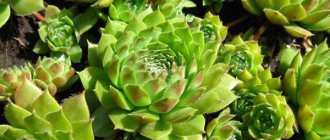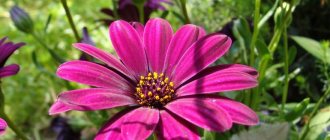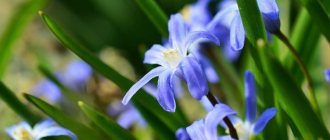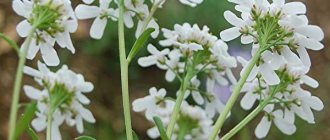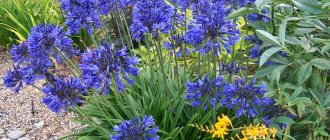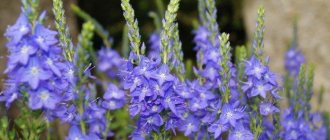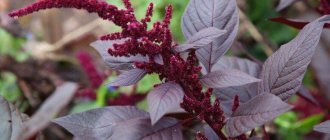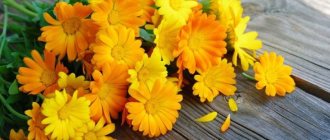Succulents are plants that are able to accumulate liquid in their own leaves and stems. Quite often they can be found in the wild in dry places. They can go without watering for a long time, as they receive nutrients from accumulated moisture. Succulents are a category of plants belonging to different families, having different chemical compositions and botanical descriptions, and also differing in appearance. They are united only by similar conditions of existence.
Succulents for open ground
All types of succulents have various devices on the surface of their leaves or stems with which they retain moisture. So, according to the method of moisture accumulation, these plants are divided into two varieties. Stem - moisture accumulates inside the stems, thereby causing them to expand and thicken in the form of a ball or bottle. Leafy species accumulate moisture only in the leaves.
Spurge
Euphorbia is native to northern Africa and is widely used as an ornamental and medicinal plant. It contains a specific milky juice that can irritate the skin. The inflorescence has leaf wrappers with a specific yellow-green color. There are species with red and yellow flowers. Plants tolerate both direct sunlight and partial shade. The genus Euphorbia contains about two thousand species, which are represented by perennial herbs and shrubs. Some of them are poisonous.
Euphorbia Mile
Rejuvenated
It is a perennial groundcover plant that is capable of forming an oval and spherical rosette of dense consistency. The leaves of Molodilo are quite fleshy, oblong or ovoid in shape. From the base of the rosette of the plant there are many stolons, which contain daughter rosettes. Peduncles are formed 14-15 cm long with small thyroid-shaped inflorescences of white, pink and red colors. The succulent blooms during June and July, after which the rosette dies off completely. Juvenile is characterized as a cold-resistant and drought-resistant plant that requires sufficient sunlight. Ideal for growing in group compositions or alone in containers and borders in garden beds.
Sedum
A perennial succulent with fleshy leaves and star-shaped flowers, which are collected in umbellate or corymbose inflorescences. Due to its unpretentiousness to the weather and climatic conditions of the growing area, it has become widespread on all continents. The leaves have a flat structure and a cylindrical shape. The arrangement of leaves on the stem is regular. Sepals and petals completely free at the base. Sedum has a very beautiful decorative form. The length of the stamens is twice the length of the petals. There are many species with high winter hardiness, so feel free to plant these succulents in your dacha.
Sedum succulent – Saxifraga
Levisia
A low herbaceous perennial plant. Levisia's leaves are elongated-ovate with wavy edges. The leaves are quite thick and dark green in color. The flowers of the succulent form a few-flowered inflorescence up to 4 cm in diameter. The flower petals are pink or pinkish-lilac with light edges and barely noticeable thin longitudinal stripes.
Bacopa
A sun-loving plant that is unpretentious to the soil. The stems are quite thin with a tendency to lodging. The leaves are very small, ovate and broadly elliptical in shape. The leaf color is green or olive green. The leaf margins have jagged edges. Flowering occurs throughout the summer. The flowers are small, tubular and bell-shaped. The perianth consists of 4 or 5 symmetrical lobes of white, blue or light blue. It is characterized by weak winter hardiness and tolerance to waterlogging of the soil, so such succulents in the country must be prepared for winter. Propagated by cuttings. In summer it is used for landscaping various reservoirs, and in winter it is perfect for use in aquariums.
Ragwort
The ragwort includes various forms: trees, vines, herbaceous plants. The inflorescence of a succulent is a basket that is similar to a dandelion or chamomile. After flowering, flying seeds quickly form in the inflorescence. Raspberry is distinguished by its unpretentiousness in cultivation. Prefers well-lit places and needs several feedings. Propagated by seeds and cuttings. Raspberry plants cannot withstand severe waterlogging of the root layer. Therefore, when growing in the garden, it is worthwhile to carefully choose a place for planting Raspberry.
Meadow cruciferous
Delosperma
This plant is native to southern Africa. In nature, there are more than a hundred species of this plant, which can be ground-covering plants or subshrubs. Very often, delosperma is grown indoors. The above-ground part of the plant is capable of growing strongly in length up to 30 cm. The stems branch quite strongly and bend easily to the ground. The root system of delosperma is highly branched and fleshy in shape. The leaves are lanceolate-shaped, curved, reaching a thickness of 3-4 mm. The aerial part is dark green and bluish. The surface of the green parts very often forms crystals of potassium salts.
Apthenia
The natural condition for the growth of Aptenia is dry subtropics or semi-deserts. On the territory of our country there are four species, low-growing with tetrahedral stems and fleshy leaves. Peduncles form on the tops of the lateral branches and in the axils of the leaves. Aptenia is very demanding of sunlight. The best way to grow a succulent is as a houseplant. In this case, it is necessary to plant in a loose grain mixture with good drainage. Propagated by stem cuttings throughout the spring.
Rejuvenated (stone rose)
Young people are endowed with mystical abilities to ward off evil spirits and neutralize negative energy.
Be that as it may, this plant deserves the attention of novice gardeners due to its unpretentiousness and variety of species.
During the flowering period, a stem covered with leaves grows from the middle of each adult rose. It is crowned with a small but brightly colored flower - the shade depends on the type and variety.
Young Reginae-Amaliae
It is the most rose-like of its species. The succulent leaves-petals have a soft green color, which in the sun can acquire a bright orange edging. Its rosettes are compact and most suitable as the main background plant in a composition of relatives.
Young Brunette
This type is more like a green crystal with a dark red tint. This is a fairly large specimen in its form; it looks great against the background of smaller juveniles and creeping sedums.
Roofing was young
This is the most frost-resistant species, because it has to survive in the conditions of a green roof, where the soil freezes through in winter. Nevertheless, bright green roses with flat petals are a welcome guest both on an alpine hill and in a modular flower garden.
Young Octopodes
It looks like charming balls with dark red petal tips.
When propagating, short branches with miniature balls at the end emerge from under the rosette - these are babies that quickly take root as soon as they land on the ground.
Hybrid youth Fame
It boasts an unusual leaf color. There are soft green, yellow, light pink shades here.
A composition of this species alone is a self-sufficient decoration of a small piece of land, and if you correctly highlight it with monochromatic green relatives, a bright color effect is guaranteed!
Juvenile Soboliferum (runner)
Soboliferum is distinguished by a small diameter rosette and a very dense planting of short leaves.
Before flowering, an adult rose produces a leafy stem up to 25 cm high, which in June-August is crowned with inflorescences of large yellow flowers. Its children, unlike the adult plant, have a crimson tint to the outer leaves.
Caring for succulents in the garden
In order for succulents to reveal their potential and be able to properly decorate the territory of the dacha, it is necessary to carry out a range of measures aimed at creating optimal conditions for the growth and development of these plants. At the same time, ignoring even one factor can lead to a slowdown in plant development or to their complete death.
Location and lighting
When growing succulents in a summer cottage, you need to be very scrupulous in choosing a growing location. Almost all species need sufficient sunlight throughout the day. Even slight shading can cause a decrease in growth activity. Therefore, you should choose a place on a site without nearby tall trees or various buildings. If succulents are grown as indoor plants, they should be placed on south-facing windows or artificial lighting should be used.
What soil is needed for succulents?
Succulents are not demanding on soil fertility. Therefore, they grow normally even on sandy soils. However, it is better to use more fertile soil for planting, as this will avoid several fertilizing and quite frequent loosening of the surface layer.
When choosing a growing location, you should not forget about the acidity of the soil, which has its own optimal indicator for each succulent. In addition to soil fertility, it is necessary to take into account its density. Indeed, in highly compacted soils, the root system develops slowly, which negatively affects the development of the entire plant.
An important soil indicator for succulents is humidity. Due to the fact that succulents do not tolerate prolonged waterlogging of the soil, it is necessary that groundwater does not approach closer than 1.5 m to the surface of the earth. When growing succulents as indoor plants or in containers, it is necessary to have a drainage layer below the soil. Therefore, we can say that succulents prefer soils of average fertility with good drainage ability and optimal soil acidity.
How to water succulents in the country and what to feed them with
Succulents are characterized by high drought resistance. In addition, the plants have a fairly powerful root system that is capable of taking water from the lower soil horizons. Therefore, when you grow succulents in the country, the plant does not need regular watering. Only during a very long dry period can one water-recharging irrigation be carried out per season.
It is advisable to fertilize at least three times per season. But for this it is necessary to use exclusively mineral fertilizers.
The use of organic matter has a negative impact on plant development.
It is best to feed succulents using solutions of liquid fertilizers, such as Vympel (12-14 ml per 10 liters of water) or Energen Aqua (11-13 ml per 10 liters of water). The first feeding is carried out at the beginning of the growing season, and the second before flowering begins. The third feeding is needed by plants in the autumn before going into winter.
Wintering species
Succulents come in different shapes, sizes and colors. But if you want to start with something really simple and reliable, then plant Sedums or Sempervivums. These perennials are among the hardiest succulents and can survive even winter if they are protected from excessive cold and moisture.
Flowers planted in wooden containers. Photo used as illustration. Source: Yandex.Images
Once you get more experience with them, you can start growing something more unusual, such as Pachyphytum, Aeonium or Echeveria. But while these plants love to grow outside during the summer months, they will need protection in the winter. If you do not have a suitable greenhouse , then during the cold weather you can bring them into the house and grow them like ordinary indoor plants.
Diseases and pests of succulents
The greatest damage to succulents is caused by fungal diseases such as fusarium and late blight. Fusarium affects the roots and gradually affects the entire above-ground part. The main symptom of the disease is stunting of growth and coloration of the plant in a pale gray color. To combat the disease, it is necessary to spray the plants with Fitosporin-M or Fitolavin.
Late blight primarily affects the root collar and subsequently damages the leaves and stems of plants. A sign of plant damage by late blight is the appearance of brown spots. To cure the affected plants, you need to treat the plants with fungicides Ridomil Gold, Horus.
Late blight on succulents
The most harmful pests are aphids and spider mites. Aphids are quickly able to create large colonies, which are located on the lower part of the leaf. These small pests feed on cell sap by sucking the curls of plant leaves. You need to fight aphids using insecticides BI-58N, Karbofos and Metafos.
Spider mites are located, like aphids, on the lower part of the leaf. The mite feeds on plant sap and a growth forms at the site of damage to leaf tissue. If the tick has multiplied greatly, then at the site of its accumulation you can see a white cobweb. To destroy mites, you need to spray plants with the insecticide Karbofos.
Sedum (Sedum)
The variety of forms of these, for the most part, perennials is expressed by shrubs, herbaceous specimens or semi-shrub characteristics. The flowering period occurs in the second half of the warm season. Excellent honey plants provide the garden with a sufficient number of pollinators, which are so necessary for many garden and vegetable crops.
All Sedums are drought tolerant, preferring open spaces. When choosing green “pets” for places with cold winters, you should pay attention to frost-resistant varieties. Guests should plant flower beds before the onset of summer, waiting for the return of possible seasonal frosts.
The main concern is the need to frequently weed out weeds that can choke out both young and adult species. The exception is, perhaps, one Caustic Sedum, which can cope on its own. Watering is carried out only when drought or extreme heat occurs.
Timely shortening of growing shoots and pruning of faded inflorescences and leaves control the decorative condition. With the onset of stable cooling, all above-ground parts are cut off at a level of up to four centimeters from the soil surface. The resulting “stumps” are awakened by the earth for wintering. Common garden species:
- The bent Cristatum (reflexum 'Cristatum') is known as “Comb”, “Cockscomb”. The varietal feature is expressed by the bright green color of the leaves, reminiscent of needles. Grows into a thick carpet;
- Vidny (S. spectabile ) is bred in large quantities with emphasis on leaf and flower color. Looks good in a group combination of different varieties, with conifers. There are quite tall specimens (0.8 meters in height);
- False (spurium) is represented by cleverly intertwined shoots that are capable of rising (more often creeping). Blooms from mid-summer. Star-shaped flowers are collected in corymbose inflorescences. Serve as bright color accents;
- Acrid (acre) is a ground cover plant. The first year, young shoots try to take root in places of contact with the ground. In the second year, during the flowering period, the green foliage is drowned in rich yellow featherbeds;
- Spanish (S. hispanicum) forms a carpet where it grows with a striking bluish tint. Having finished blooming, all shoots die off. Rapid revival occurs by self-seeding.
What is Haworthia?
This variety of succulents is distinguished by its fleshy leaves, the edges of which have pointed bases. There may be small white thorns around the perimeter of the plant.
The length of the leaf plates reaches 10 cm. Many gardeners fell in love with it for its decorative coloring and unusual leaf shape. Outwardly, they resemble cuttlefish.
Apthenia
The most common throughout the Russian territory is Cordifolia (Ap. cordifolia), another name is Mesembryanthemum cordifolium. Requires sufficient but diffused light content. When placed in open areas, gradual adaptation to direct sunlight is necessary.
The optimal temperature is from 22° to 25 warm degrees. It tolerates wintering without complications. It is advisable to plant individually (rapid development contributes to a negative neighborhood). Its maintenance is minimal. Excess moisture should be avoided.
Bacopa
The most popular are Monnier and hanging varieties. Long hanging shoots look beautiful on hills. The earth's surface is lined with a rich carpet with moving flowering foci. Transitions happen smoothly. Little stars flash and gradually go out, only to light up again.
Euphorbia myrtifolia
This perennial representative of the Euphorbia with the Latin name Euphorbia myrsinites is decorative with thick shoots creeping along the surface of the ground, spirally dotted with pointed, scale-like leaves. The heat-loving species is preferable for the southern regions. Requires placement in open sunny spaces. Just like the main part of succulent plants, it does not tolerate abundance of water.
Features of plant flowering
Some hybrids require special conditions, otherwise they will not bloom.
Important! Echeverias in mixes (small sizes) are usually used to build flower ensembles
Blooming succulent
Period of activity and rest
In the spring and summer months, echeveria blooms for 14-30 days. In winter, most of the representatives of the genus retire. At this time, the regime is seriously changed: the temperature is reduced to 8-15 ℃ and irrigation is reduced to one procedure per month.
Types and shape of flowers
Small buds are located in inflorescences located on a vertical lateral peduncle. The tone of the petals depends on the lighting conditions:
- lack of sun causes yellowness;
- a sufficient amount - a reddish or orange tint.
At the end of the budding period, babies are formed on the peduncles.
Argyroderma or "flowers of life"
This name translated means silver base. The plant is a round succulent with a bluish tint.
The surface of the flower is smooth.
The leaves are made in the form of small spines with soft pile around the entire perimeter. Short peduncles with a bright bud inside are formed in the center of the flower. Outwardly, it resembles a garden aster flower.
Levisia
The place for planting should be chosen in partial shade. Direct rays are bad for the health of the plant. It is recommended to cover the root collar with gravel to avoid waterlogging. There are two ways to grow outdoors: sowing seeds before winter (late October) and placing seedlings closer to summer.
Representatives of this vegetation overwinter under the cover of a glass jar, which prevents excess moisture from entering the above-ground parts of the plant during the thaw period. Deciduous specimens tolerate frost even without shelter. Care should be taken when watering: water should fall strictly into the root zone, without touching the leaf rosette. During prolonged rainfall, it is necessary to limit moisture by covering the bushes with halves of plastic containers.
Blooming Levisia in composition
Reproduction
Young plants
You can propagate succulents in 4 ways:
Seeds Required conditions:
- Planting material must be fresh. They need to be washed before planting.
- The substrate is sand and peat. Before planting, it must be disinfected by calcining it in the oven.
- The pot must have drainage holes
A drainage layer is placed at the bottom of the pot, and soil is poured on top . Before planting, it must be moistened by placing it in a tray with water. Next, you can sow the seeds.
Maintain the temperature around 22 degrees. Before the emergence of seedlings, sharp jumps should not be allowed. Plant shoots begin to appear after 20 days. You may have to wait longer, depending on the quality of the seeds.
The plant should be replanted no earlier than after 6 months. After diving, young succulents need to be shaded. This will help them quickly adapt to new conditions.
Cuttings To plant a new plant, the cuttings must be healthy and undamaged. After the cut, you need to put it on the window so that the cut can air for 2 - 3 days. Then it is planted in a pot.
Do not place succulent cuttings in water. They will begin to rot in it and will not take root.
The stems and leaves take root in about 14 days. You need to water regularly as the substrate dries out.
Leaf The leaf of the plant should be placed in a pot with loosened soil. Lightly press it into the ground. Next, leave it for two weeks. It will take root on its own and give birth to children.
Types of succulents that can be propagated from leaves. These include:
- Crassula
- Kalanchoe
- Sedum
- Pachyphytum
Vegetatively Some succulents grow babies on their leaves, already with roots, for example, Kalanchoe. All that remains is to collect them and plant them in the soil.
Other types of plants produce babies, for example, haworthia and aloe . They are carefully separated from the mother plant and planted.
Creeping varieties of succulents, such as delosperma, can be propagated by layering. The stem of the plant is dug in, after the roots appear, it is separated and transplanted into a separate pot.
How to grow Lithops at home?
This variety of succulents is considered very rare. She is very high maintenance. The plant is an oval element that bears some resemblance to a pebble.
During flowering, a small peduncle forms inside the stem. The flower evenly covers the fleshy base and has a pleasant smell.
As for the color palette, depending on the Lithops variety, it can be a bright purple hue or a pale yellow color.
Ragwort
This plant has many species, among which there are also garden representatives, of which the species familiar to us all is Ashy groundsel. In the last decade, this plant has become a popular guest in flower beds, both urban and in private gardens. The name is synonymous - Jacobea maritima or silver cineraria. The plant is not whimsical and thrives in partial shade. The inflorescences are unsightly yellow flowers. The dissected leaves covered with white edges make cineraria especially decorative.
There are other types of ragwort that get along well in the garden, you can read about them in our article:
“Tree of Happiness” or Crassula succulent
This type of succulent is found in every apartment. Some gardeners call it the “money tree.” The round leaves are dense to the touch and resemble neat coins.
According to the legend of some gardeners, this plant is considered a real amulet for attracting financial wealth. The more magnificent its crown, the more money there will be in the house. However, this is just a superstition that was invented by amateur flower growers themselves.
The height of an adult plant can reach up to 80 cm, and the width of the bush up to 50 cm. The base of the succulent is presented in the form of a powerful trunk, the diameter of which can reach 8 cm.
As for care and cultivation, the plant is quite unpretentious for keeping at home. To do this, just place the pot with the plant on the south side. Watering should be done once a week.
Mesembiranthemum cordifolia
The most spectacular of the short-lived succulents, Mesembryanthemum cordifolium, or Aptenia, has long remained unnoticed by gardeners. Fleshy, neat, densely sessile heart-shaped, lanceolate leaves on densely branching drooping shoots and bright colors allow mesembryanthemums to create very dense and elegant, cascading bushes.
Mesembryanthemum cordifolium. skylark
When baskets of flowers reminiscent of asters and chrysanthemums bloom at the tops of the shoots, you can’t take your eyes off the bushes. Their palette includes all pink-red shades.
Without a cool winter, it is difficult to achieve success from this plant. Extremely light-loving, mesembryanthemums adore fresh air and minimal, stable humidity.
